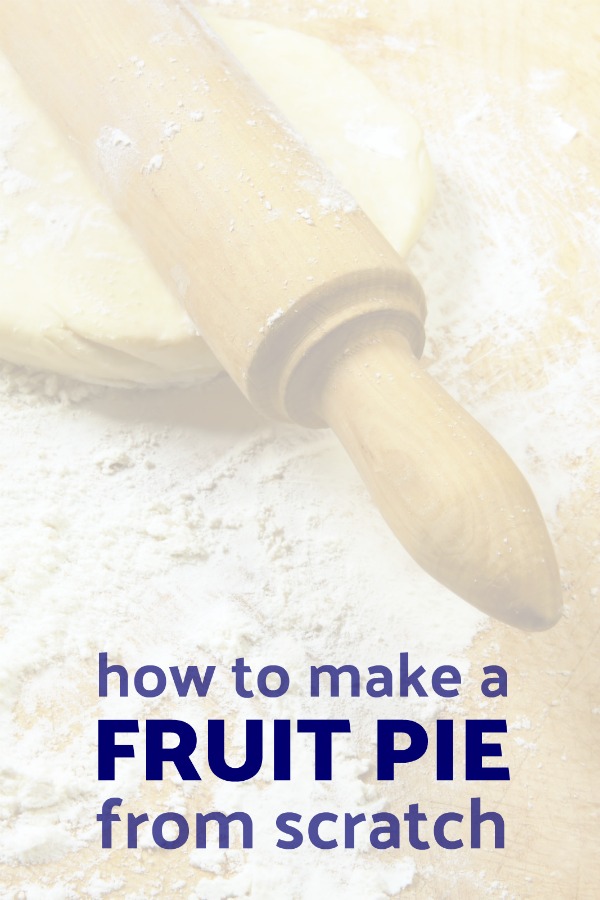
To be honest, I don’t particularly like pie. If I am going to spend time and energy and calories on a dessert, it’s got to involve chocolate.
However, in the immortal words of Meatloaf, I would do anything for love. I love my husband, and my husband loves pie.
Lately, he has been not-so-subtly beating around the bush for a blackberry pie. So, on Monday I told him that if he picked the berries, I would make him a pie. That man was motivated; he brought eight cups back to the house in no time flat. Ugh. My turn.
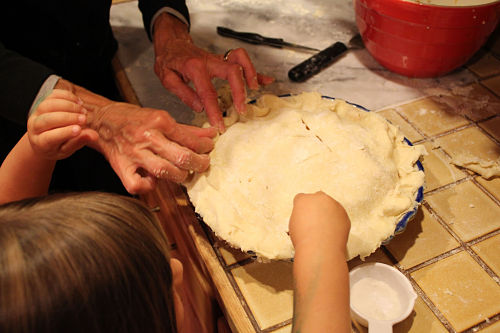
As a kid, I have very strong memories of watching my mom in the kitchen. She moves with effortless grace. Most foods were made from scratch, and all things were made well. Her pie crusts were no exception.
She never used a recipe, and she always made it look so stinking easy. I can still picture her rolling and flipping pie crusts into the dish with a quick flick of the wrist and without breaking a sweat.
Sounds inspiring, right?
It’s actually incredibly frustrating. Making pie crusts from scratch is just one of those things that gets easier with time and practice and patience. Your first attempts will most likely stick and tear and have you on the verge of pitching the whole mess into the garbage can. But it does get easier. The results do get better. And your time and effort will be totally worth it.
When I was working full-time outside of our home, I did what any sane, pastry-phobic person would do. I purchased pie crusts from the grocery store. They weren’t as good as the real deal, but they sure were easier. Now that I am trying to make the majority of our baked goods from scratch using real ingredients, I ditched the dough boy.
With a little practice and confidence, making pie crusts from scratch really is possible. To prove it, I am going to walk you through the steps. Ready? Here we go…
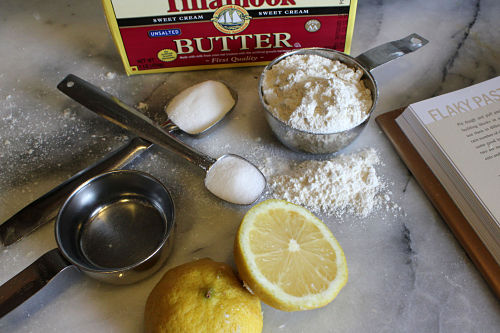
Okay, first things first. Confidence. I am convinced that, like bees, bears, and children, pie dough can smell fear. You have to walk into your kitchen like you own the place and show that crust who’s boss. Work with confident hands. New to baking with pastry? Just fake it. Wimpy, timid hands need not apply. Seriously. I’m convinced this was my mom’s secret weapon.
Now, we can talk about ingredients. There are a bunch of different ways to make a pie crust. The one I am featuring is based on The Grand Central Baking Book (Amazon). Feel free to tweak the ingredients or techniques to suit your own time and tastes.
- Butter is better. I stopped using shortening last year, and I don’t miss it a bit. Starting with nice cold butter is key for perfect pastry.
- Sugar is optional, but it gives the pastry a bit of sweetness and a golden crust.
- Unbleached, all-purpose flour
- Salt gives flavor to the crust and is a nice balance to the sweet filling. If you are using salted butter, cut the salt in half.
- Water hydrates the dry ingredients, pulling them together. Use ice water to keep the mixture as cold as possible.
- Lemon juice is also optional. I read that it improves the crust’s color and helps relax the gluten, keeping your dough from pulling back as you roll it out. It does give the dough a slight citrus flavor so it’s your call if you want to use it.
- Fillings can be anything from sweet to savory. We currently have lots of great options, like berries, apples, and peaches, available right here in the Northwest.
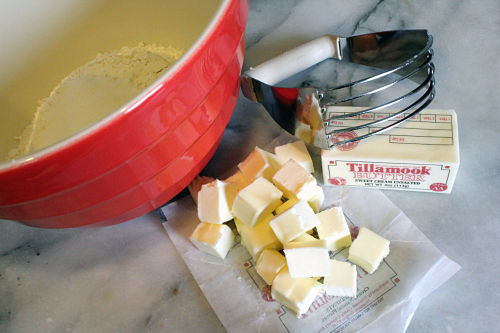
The most important tip for success when making pie dough is to keep the ingredients cold. Make a little bit of room in your refrigerator or freezer before you get started. Warm, greasy butter is the enemy of tender crust; if it melts into the flour, you’ll get a tough, crispy crust that’s more like a cracker.
The ingredients should be cold during every state of mixing. If you’re a novice, chill everything to begin with, and don’t hesitate to put your dough in the refrigerator at any point if it begins to warm up.
The Grand Central Baking Book (Amazon) by Piper Davis & Ellen Jackson
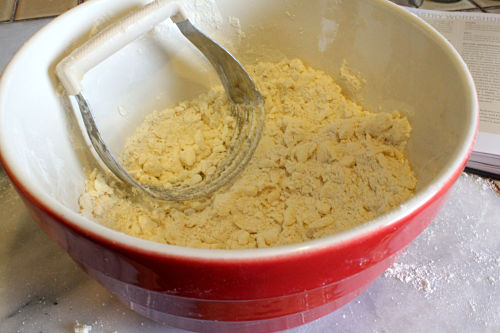
After dicing the cold butter into 1/2″ cubes, you will cut it into your dry ingredients. You can use a mixer or food processor, but I prefer using my fingers or a pastry blender.
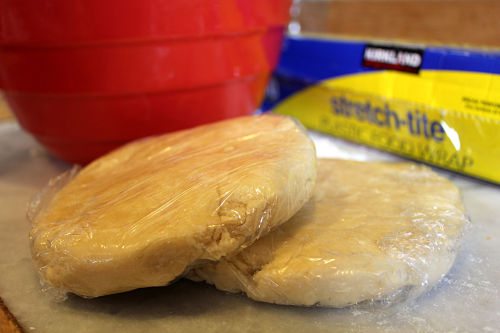
Don’t just dump the liquid into the dry ingredients; you most likely will not need the entire amount called for in a recipe. Adding too much liquid will give you a tough dough. Drizzle the ice water over the dry ingredients, mixing gently with a fork. Gather a small fistful of dough; if it holds together you have enough liquid. If it is still crumbly, add more ice water a tablespoon at a time.
Ready for a break? Good. So is the dough.
Split it evenly and shape it into two rough disks. Cover the dough in plastic wrap and place it in the refrigerator for 1-2 hours (or up to several days). This really is the key for rolling out a nice, smooth crust that doesn’t stick or tear.
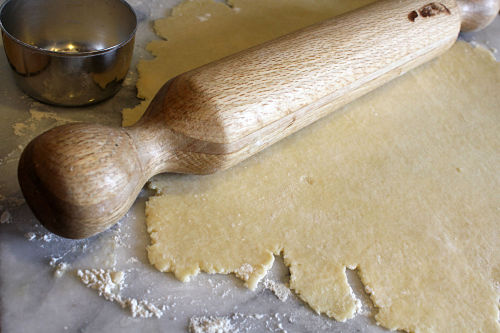
Working with one chilled disk at a time, roll the dough out on a lightly floured surface, starting in the middle and turning the dough as you roll. Don’t get discouraged with this step. It really does get easier with practice. If your dough starts to stick, return it to the refrigerator or add a bit more flour to the rolling pin or surface.
If you’re nervous about the whole rolling pin thing, no problem. Try this method to build up your confidence: Roll out your crusts, one at a time, in between two sheets of wax paper or plastic wrap. This will keep the dough from sticking to the surface and make it easier to transfer from the counter top to the pie dish.
Whatever method you use, just take your time and be patient with the process.
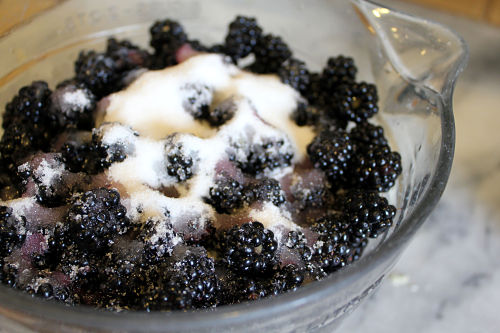
Toss your filling with sugar and cornstarch. The sweeter your fruit, the less sugar you will need to use. For 7-8 cups of blackberries, I only used 1/2 cup of sugar. Cornstarch is a thickening agent; you could also use flour or tapioca.

Roll out the bottom crust, making it slightly bigger than the diameter of the pie plate (this Pyrex 9″ Bakeware Pie Plate is perfect for just about any pie!). Add your berries. Most standard berry pie recipes call for a measly 4 cups of fruit. I usually dump in 6-8 cups for a fuller pie and a messier oven.
Also, if you have trouble with runny pie fillings, try this: Sprinkle a few tablespoons of finely crushed graham cracker crumbs on the bottom crust of your pie before adding the fruit on top. The crumbs will help soak up the juice, without changing the flavor or consistency of the pie.
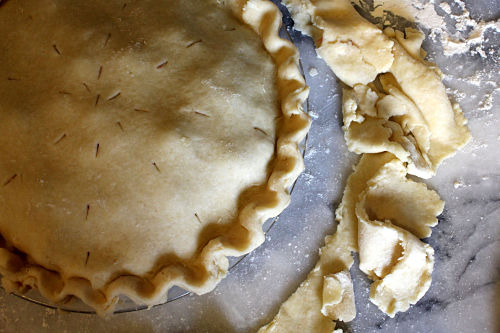
Repeat the process with the top crust. Once it is rolled out, slide your hands, palms down, under the crust and carefully set it over your pie filling. Using a knife, trim off the excess dough. Gently press the edges together to seal. Crimp the edges using your thumbs and forefingers.
Cut some vent holes in the top of your pie. You could also brush milk, water, or a beaten egg on the top crust and sprinkle with sugar.
It can look super fancy and perfect. Or not. In the grand scheme of things, a good tasting pie is better than a pretty one.
That’s it! You just (vicariously) made a pie.
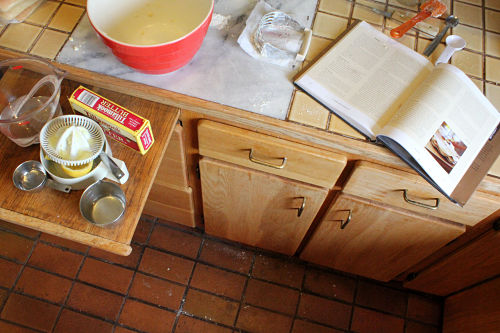
Your kitchen will look something like this.
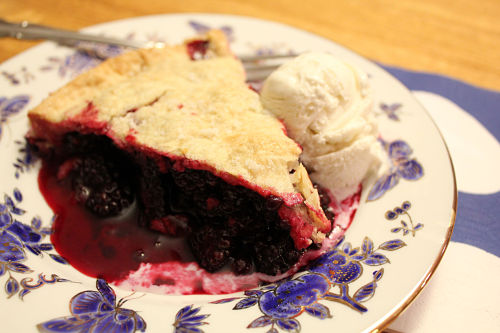
Your pie will look like this.
Your family will look happy (and hopefully offer to do the dishes).
See? I told you it would be worth it.
All-Butter Flaky Pie Dough
Slightly adapted from The Grand Central Baking Book (Amazon)
Yield: double crust
Ingredients
2 1/2 c. all-purpose flour
2 T. sugar
1-2 t. salt
1 c. butter
1/3 c. ice water
1 T. lemon juice, optional
Basic Fruit Filling
Ingredients
6 c. fruit
3/4-1 1/2 c. sugar (depending on fruit’s sweetness)
1/4 c. cornstarch
- Mix the flour, sugar, and salt together in a medium bowl.
- Dice the cold butter into 1/2″ cubes and toss into the dry mixture. Moving quickly, use your fingers or a pastry blender to cut the butter into the flour until it is all incorporated and no large chunks remain.
- Fill a cup with water and ice cubes. Put the lemon juice (if using) into a liquid measuring cup, then add 1/3 cup of ice water. Be careful not to add any of the ice. Drizzle the water into the dry mixture, reserving some of the liquid. Use a fork or rubber spatula to gently mix the wet and dry ingredients together. Check the hydration of the dough by gathering a small fistful; if it holds together, it’s ready. If it’s still crumbly, add more water a tablespoon at a time.
- When the dough comes together, form it into two separate flat disks. Wrap and place in the refrigerator for 1-2 hours or days.
- Working with one disk at a time, place it on a lightly floured smooth surface. Using a lightly floured rolling pin, begin in the middle of the dough and roll outward rotating the dough and adding more flour as needed. Continue rolling until the dough is slightly larger than the diameter of the pie plate.
- Fold the bottom crust in half and transfer it to the pie plate. Using your fingertips, press it gently against the sides of the dish.
- Mix together the fruit, sugar, and cornstarch. Pour into the prepared crust and refrigerate.
- Repeat the process for the top crust. Place on top of your filling and trim the edges with a knife. Crimp the border using your thumb and forefingers. Use a sharp knife to cut steam vents in the top of the pie. Place the pie on a baking sheet. (Pies can be frozen at this point to be baked, without defrosting, at a later time.)
- Bake at 400 for 20 minutes. Reduce oven temperature to 350. Bake for 30 more minutes, or until the crust is golden brown and the filling is bubbling.
*********************************************************************************
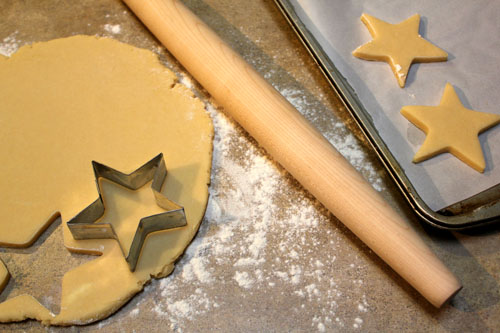
Something about this French Rolling Pin makes rolling out dough a pleasure instead of a pain. It’s smooth, lightweight, and easy to use: the perfect rolling pin. It is definitely one of those kitchen tools that I now look forward pulling out of the drawer and putting to use. The simple design is both beautiful and useful.
RELATED: Best gift ideas for the baker (this rolling pin is on the list!)
The Grand Central Baking Book: Breakfast Pastries, Cookies, Pies, and Satisfying Savories from the Pacific Northwest’s Celebrated Bakery comes from the extremely popular Grand Central Bakery in Portland and Seattle. The cookbook gets great reviews and will allow you to make some of their delicious pastries and baked goods at home!
Looking for more delicious pie recipes?
Follow Frugal Living NW on Pinterest!
Fantastic range of boards from best recipes and tips for frugal living to gardening and budgeting help.
This post may contain affiliate links. See the disclosure policy for more information.

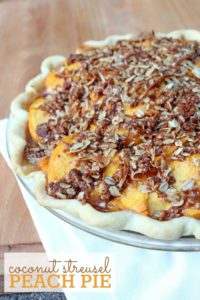

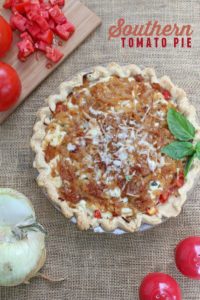
My favorite tip for making pie crust is to roll out the dough between two sheets of parchment paper (still use the flour). When you’re ready to move it to the pan, just peel off the top layer and use the bottom paper to flip it in.
PS. Don’t forget to use the trimmings off the sides for a special treat-pie crust cookies. Roll them as thin as you can between parchment. Leave them on the bottom parchment and slide on a cookie sheet to bake. Butter the crust cookies and sprinkle them generously with cinnamon sugar. Bake til brown and crispy-mmm.
My favorite pie crust tip is to roll out your dough between two sheets of parchment paper (still use the flour). Then peel off the top layer and use the bottom paper to flip the crust into the pan (or on top of the pie). It eliminates the tearing when trying to move it in and just makes the whole process a lot easier:-) You can also use wax paper if you don’t have parchment.
Excellent instructional guide. But you mentioned Meatloaf and pie in the same paragraph, giving me a sudden craving for comfort food.
I made this last night with marionberries and will be taking it to my parent’s house for Thanksgiving. It looks delicious and I can’t wait to eat it! Thanks for the step by step instructions. I haven’t attempted a homemade pie crust in a long time. I’ll definitely be using this recipe again.
This is a really nice tutorial on making a pie. I make my crust with butter, exactly as your recipe. I find it is such a good crust. I won’t use any other crust recipe.
Thanks for sharing your pie with us !
A great option if you like making pie at home but don’t always want to be making the dough each time is to make a larger batch of dough and freeze it when you come to the disk stage. You can then just pull them out of the freezer and let them come to a nice working temp. It works great. Julie Richardson of Baker and Spice here in Portland also has a great book out called Rustic Fruit Desserts that has a large batch recipe for pie dough with great directions.
Thank you! I didn’t know this secret of keeping everything cold. Back when I used to try to make pies, I actually made a lemon meringue pie from scratch. Naturally, it took me several tries to get a crust that looked decent. Unfortunately, after it was all finished and I had browned the meringue, I dropped it on the floor upside down as I was taking it out of the oven. I swore that day then and there that that would be my last pie. Now, after looking at your instructions, and knowing now to use two oven mitts, I want to attempt it again. Pie-making is becoming a lost art. I remember my grandmother’s blackberry pies so well…ahhh!
Love the multi generational photo of the expert passing on the skill of pie baking to the little one, great memories start in the kitchen.
One of my neighborhood moms used to make a pie crust with white vinegar (totally from scratch, naturally!) After reading your delightful tutorial, it reminded me of her pie—-it was like, THE BEST PIE EVER! I have never had a crust so good, and I’ve never been able to make one that tasted that good either. I stopped making pies in my house because……well…..no one likes pie but ME. My beloved is good for one piece, the kids will only eat it if its pumpkin, so if I make a berry pie………….its a war between “I can’t let it go to waste” and “I can’t let it go to WAIST”!
I have always used my moms pie crust recipe and she got hers from her grandma my great grandma. You use 2/3 cups of crisco NOT BUTTER and divide it in half with 2 cups flour 1 teaspoon salt mix the first half with a fork till corn meal size then the other half till pea size. Then you add in your ice water 1 tablespoon at a time about 6 in all. For my filling like apple or berry I use 1 cup suagar 1 teasoon cinnimon and 3 tablespoons of flour mix it in with the fruit top with 4 pads of butter. Cover the top and bake for 50 min 400 degrees.
My mom uses an oil recipe (not shortening) from an old Betty Crocker cookbook.
I find if I make about twice what I’m supposed to need, I end up with enough (rolling is not my strong suit).
It really is soooo good.
Great detailed tutorial. Thanks!
We have a lot of zucchini, so I recently made zucchini cobblers and took them into my husbands work–they loved it, and couldn’t believe it had zucchini in it! It was billed as a mock apple pie, and since I like to mix other fruits with my apple pie, I did that with the zucchini too. I realized that if I cut the zucchini lengthwise, peel, seed and slice it, it even looks like apple slices! Mixed with real fruit, you can slip it into a pie with any fruit you’d mix with apple it stretches the fruit (if you’re short) and uses up some of that zucchini that’s over running the garden!
thanks for making this look easy enough to try! The results look soooo delicious!
I got tired just skimming your instructions. No thanks, I’m with you (if it isn’t chocolate, it isn’t worth it). But kudos to you for this act of love.
My Mother is exactly as you describe yours when she works in the kitchen. Two things: When I wanted to tackle making a pie for the first time, she told me everything I would need and was surprised I didn’t have have of what was needed (ie. sifter, the dicer thingy, rolling pin, etc.). I simply told her “I never bake. You always did, so if you haven’t bought the equipment for me, then I don’t have it.”
Then, one year she tried to “cheat” and used store bought pie crusts. It totally burned! She hasn’t burned anything in years. I told that is what she gets for cheating. Bakers have to bake and seldom can get away with new ways to cut corners.
I also add cinnamon and extra vanilla extract to my pies. Lemon also helps offset some of the sweetness and gives more depth to the flavors. My favorite lately has been apple/pear pie. Reducing the apple/pear mixture ahead of time really makes it taste yummy! I don’t like cornstarch so I always use flour.
I am in love with Grand Central’s cookbook. Have you tried the coffee cake recipe yet? I made it with blackberries a couple weeks ago and it was delish!
Looks YAM!
My trick – for EVERY pie (cherry esp) is to add about 2 – 3 teaspoons of good quality cinnamon to the pie (did this with peach recently and co workers were like oh my gosh best pie ever)
My husband LOVES anything with vanilla extract in it – so I normally add some of that too